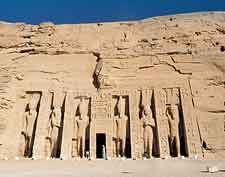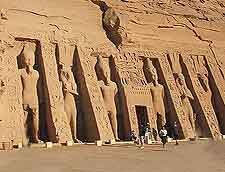Abu Simbel History Facts and Timeline
(Abu Simbel, Egypt)

Although they may not be as grand as the pyramids of Giza, the UNESCO World Heritage temples of historic Abu Simbel, the 'Nubian Monuments', are remarkable nonetheless and boast a prominent place in both Egyptian history and present-day tourism.
These massive temples to the gods were hewn out of sandstone cliffs by pharaoh Ramesses II over 3,200 years ago and were subsequently lost to the sands, rediscovered and then moved to higher ground beyond the rising waters of Lake Nasser.
The Building of Abu Simbel
King Ramesses II, of the 19th Dynasty, came to the Nubia region during his 67-year reign and decided to construct grand temples out of the sandstone cliffs sited next to the River Nile. He did this mainly to commemorate his war victories and to impress the Nubians (northern Sudanese) to the south.
The temples were begun around 1274 BC and were some 30 years in the making, clearly defining the start of the history of Abu Simbel. The main complex, known as the 'Temple of Ramesses, beloved by Amon', was dedicated to the gods Ra-Horakhty and Amon-Ra (Amun), as well as to Ptah. The four statues stand some 20 metres / 66 feet high and are all of Ramesses. Five other temples were built in the region, in addition to the Temple of Ramesses.
The Temple of Hathor is the other major landmark in the area, being built at the same time as the grand temples. It is smaller and contains six statues, of which four depict Ramesses, and the other two, his beautiful wife Queen Nefertari. It lies adjacent to the main temple complex.
Lost, Recovered and Relocated
Sand enveloped, hid and protected the temples over the millennia until Swiss orientalist JL Burckhardt came across the top of the Great Temple in 1813. He told Giovanni Belzoni, an Italian explorer, about his exciting discovery. Undeterred by his failure to find an entrance, Belzoni returned to the site in 1817 and eventually found his way in, thus making Abu Simbel history.
The building of the
Aswan High Dam was to ultimately threaten Abu Simbel. However, following sizeable donations from around the world in the year of 1959, with a view to saving these grand monuments, the temples were diced and relocated to a higher point in the 1960s, as Lake Nasser encroached.

What's in a Name?
'Abu Simbel' is historically said to be a young boy who brought the European discoverers to the temples in the early 1800s. The story goes that the boy had seen the buried temple on occasion as the sands shifted, and so the site was subsequently named in his honour, as tour guides eagerly recount to tourists today.
Light and Sound Show
The temples are visited by thousands of tourists every day, many coming via Aswan, farther downstream. They are, of course, best seen by day, although the Light and Sound Show also gives a fine perspective by night. The show is from 20:00 to 21:00 in summer and 19:00 to 20:00 in winter, nightly. Also popular are the audio-guides, which provide in-depth commentary on the temples and impart the fascinating history of Abu Simbel.
 Although they may not be as grand as the pyramids of Giza, the UNESCO World Heritage temples of historic Abu Simbel, the 'Nubian Monuments', are remarkable nonetheless and boast a prominent place in both Egyptian history and present-day tourism.
Although they may not be as grand as the pyramids of Giza, the UNESCO World Heritage temples of historic Abu Simbel, the 'Nubian Monuments', are remarkable nonetheless and boast a prominent place in both Egyptian history and present-day tourism.